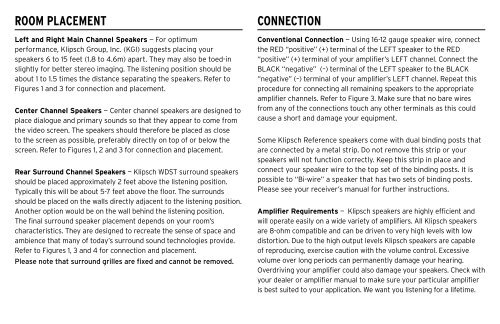Klipsch Enceinte centrale Klipsch R-25C - notice
Klipsch Enceinte centrale Klipsch R-25C - notice
Klipsch Enceinte centrale Klipsch R-25C - notice
Create successful ePaper yourself
Turn your PDF publications into a flip-book with our unique Google optimized e-Paper software.
ROOM PLACEMENT<br />
Left and Right Main Channel Speakers — For optimum<br />
performance, <strong>Klipsch</strong> Group, Inc. (KGI) suggests placing your<br />
speakers 6 to 15 feet (1.8 to 4.6m) apart. They may also be toed-in<br />
slightly for better stereo imaging. The listening position should be<br />
about 1 to 1.5 times the distance separating the speakers. Refer to<br />
Figures 1 and 3 for connection and placement.<br />
Center Channel Speakers — Center channel speakers are designed to<br />
place dialogue and primary sounds so that they appear to come from<br />
the video screen. The speakers should therefore be placed as close<br />
to the screen as possible, preferably directly on top of or below the<br />
screen. Refer to Figures 1, 2 and 3 for connection and placement.<br />
Rear Surround Channel Speakers — <strong>Klipsch</strong> WDST surround speakers<br />
should be placed approximately 2 feet above the listening position.<br />
Typically this will be about 5-7 feet above the floor. The surrounds<br />
should be placed on the walls directly adjacent to the listening position.<br />
Another option would be on the wall behind the listening position.<br />
The final surround speaker placement depends on your room’s<br />
characteristics. They are designed to recreate the sense of space and<br />
ambience that many of today’s surround sound technologies provide.<br />
Refer to Figures 1, 3 and 4 for connection and placement.<br />
Please note that surround grilles are fixed and cannot be removed.<br />
CONNECTION<br />
Conventional Connection — Using 16-12 gauge speaker wire, connect<br />
the RED “positive” (+) terminal of the LEFT speaker to the RED<br />
“positive” (+) terminal of your amplifier’s LEFT channel. Connect the<br />
BLACK “negative” (–) terminal of the LEFT speaker to the BLACK<br />
“negative” (–) terminal of your amplifier’s LEFT channel. Repeat this<br />
procedure for connecting all remaining speakers to the appropriate<br />
amplifier channels. Refer to Figure 3. Make sure that no bare wires<br />
from any of the connections touch any other terminals as this could<br />
cause a short and damage your equipment.<br />
Some <strong>Klipsch</strong> Reference speakers come with dual binding posts that<br />
are connected by a metal strip. Do not remove this strip or your<br />
speakers will not function correctly. Keep this strip in place and<br />
connect your speaker wire to the top set of the binding posts. It is<br />
possible to “Bi-wire” a speaker that has two sets of binding posts.<br />
Please see your receiver’s manual for further instructions.<br />
Amplifier Requirements — <strong>Klipsch</strong> speakers are highly efficient and<br />
will operate easily on a wide variety of amplifiers. All <strong>Klipsch</strong> speakers<br />
are 8-ohm compatible and can be driven to very high levels with low<br />
distortion. Due to the high output levels <strong>Klipsch</strong> speakers are capable<br />
of reproducing, exercise caution with the volume control. Excessive<br />
volume over long periods can permanently damage your hearing.<br />
Overdriving your amplifier could also damage your speakers. Check with<br />
your dealer or amplifier manual to make sure your particular amplifier<br />
is best suited to your application. We want you listening for a lifetime.
















